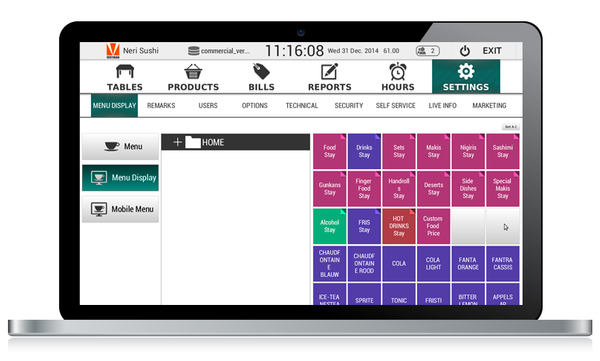Exactly How POS System Functions: A Comprehensive Overview for Service Owners
A POS system works as an essential tool for modern-day businesses, incorporating numerous parts to improve operations. It includes equipment like barcode scanners and software application to buy tracking. This system not only refines transactions yet likewise handles stock and assesses consumer behavior. Comprehending its performance can substantially influence a company's performance and decision-making. What are the crucial elements that add to this efficiency? Exploring these components uses important insights.
Comprehending the Parts of a POS System
A Factor of Sale (POS) system is made up of a number of crucial parts that collaborate to facilitate transactions and manage organization procedures. At its core, the hardware consists of tools such as a money register, barcode scanner, receipt printer, and settlement terminal, all essential for processing sales (Restaurant POS Software). The software part handles supply, sales tracking, and consumer data, supplying useful understandings for business decisions.Additionally, data sources store purchase documents and customer details, guaranteeing data stability and protection. Network connection allows real-time updates and accessibility to cloud-based solutions, boosting operational performance. User interfaces, created for convenience of use, permit personnel to browse the system swiftly, decreasing training time. Together, these components produce a natural system that improves the sales procedure, boosts customer support, and help in efficient management of service sources. Understanding these parts is important for local business owner seeking to maximize their POS systems
How Sales Purchases Are Refined
When a consumer determines to buy, the sales transaction launches a series of methodical actions within the POS system. The cashier inputs the products being purchased, which are checked through a barcode reader or by hand gotten in. This action gets item details, including rates and suitable tax obligations, from the system's database.Next, the client exists with the complete amount due. The POS system after that refines the settlement, whether with cash, charge card, or mobile payment methods. For digital settlements, the POS safely communicates with repayment processors to license and confirm the transaction.Once the payment is validated, the system generates a receipt, which can be printed or sent out digitally. This invoice acts as evidence of purchase for the consumer. The purchase data is tape-recorded in the system, making certain accurate sales documents and economic monitoring for the business.
Supply Management and Monitoring
Efficient supply administration and monitoring are essential elements of a POS system, as they assure that companies maintain ideal supply degrees and lessen disparities. A durable POS system permits for real-time inventory updates, mirroring sales and returns instantaneously. This allows entrepreneur to monitor supply levels accurately, making sure that prominent items are readily offered while protecting against overstocking of less prominent products.Additionally, progressed POS systems supply attributes such as computerized supply alerts and reorder suggestions, enhancing the procurement procedure. Barcoding and RFID innovation enhance precision in tracking inventory motion, minimizing human mistake. Considerable reporting tools offer insights into stock turnover rates, helping businesses make notified decisions about acquiring and item offerings. Eventually, reliable inventory management via a POS system not only boosts functional efficiency however additionally enhances consumer complete satisfaction by guaranteeing item availability.

Assessing Client Information and Insights
Consumer data evaluation functions as a powerful tool for businesses utilizing a POS system. By collecting and examining deal data, businesses can uncover important understandings about client habits and preferences. This analysis enables them to recognize purchasing trends, peak shopping times, and popular products, consequently informing inventory decisions and marketing strategies.Additionally, organizations can segment their customer base, permitting for individualized marketing efforts that deal with check my source specific demographics or purchasing practices. Understanding customer commitment patterns also aids in developing targeted promos and rewards programs.The information amassed from a POS system can also disclose understandings into customer responses, allowing organizations to make educated choices pertaining to item offerings and service enhancements. Eventually, leveraging customer information properly can boost the general shopping experience, foster consumer contentment, and drive profits growth.
Advantages of Carrying Out a POS System
Executing a POS system provides countless benefits that can significantly enhance business operations. To start with, it streamlines purchase processes, decreasing delay times this website and boosting consumer satisfaction. By automating sales processes, companies can minimize human error and warranty exact record-keeping. Furthermore, a POS system supplies useful information analytics, enabling proprietors to track sales fads and stock degrees in real-time. This insight sustains educated decision-making, helping to enhance stock management and advertising strategies.Moreover, lots of POS systems integrate with other service devices, such as audit software program, simplifying monetary management. Enhanced staff member management functions, such as tracking hours and performance, additional contribute to operational efficiency.Lastly, the execution of a POS system can result in enhanced revenue via boosted consumer experiences and tactical understandings, ultimately cultivating service development and sustainability.
Frequently Asked Concerns
What Kinds of Organizations Can Take Advantage Of a POS System?

How Much Does a POS System Generally Cost?
The expense of a POS system usually ranges from a couple of hundred to numerous thousand dollars, depending on features, hardware, and software - Restaurant POS Software. Companies view publisher site must consider ongoing costs for maintenance, assistance, and purchase handling when budgeting

Can I Integrate a POS System With Existing Software?
Integrating a POS system with existing software application is usually practical. Numerous systems use APIs or built-in compatibility attributes, allowing organizations to enhance operations and enhance capability by attaching numerous software application applications efficiently.
What Training Is Needed for Team to Utilize a POS System?
Educating for personnel to utilize a POS system typically includes understanding software application functionalities, refining deals, managing stock, and taking care of customer communications - Restaurant POS Software. Practical presentations and hands-on session boost efficiency and confidence in operation the system effectively
What Occurs if the Web Goes Down While Utilizing a POS System?
If the web goes down throughout POS system use, purchases may be interrupted. Several systems offer offline capabilities, permitting fundamental operations to continue, but complete capability, including real-time supply updates, will certainly be restricted.